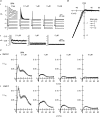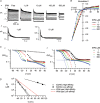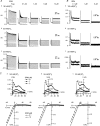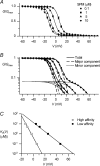Low-affinity spermine block mediating outward currents through Kir2.1 and Kir2.2 inward rectifier potassium channels
- PMID: 17640933
- PMCID: PMC2277198
- DOI: 10.1113/jphysiol.2007.136028
Low-affinity spermine block mediating outward currents through Kir2.1 and Kir2.2 inward rectifier potassium channels
Abstract
The outward component of the strong inward rectifier K(+) current (I(Kir)) plays a pivotal role in polarizing the membranes of excitable and non-excitable cells and is regulated by voltage-dependent channel block by internal cations. Using the Kir2.1 channel, we previously showed that a small fraction of the conductance susceptible only to a low-affinity mode of block likely carries a large portion of the outward current. To further examine the relevance of the low-affinity block to outward I(Kir) and to explore its molecular mechanism, we studied the block of the Kir2.1 and Kir2.2 channels by spermine, which is the principal Kir2 channel blocker. Current-voltage relations of outward Kir2.2 currents showed a peak, a plateau and two peaks in the presence of 10, 1 and 0.1 microm spermine, respectively, which was explained by the presence of two conductances that differ in their susceptibility to spermine block. When the current-voltage relations showed one peak, like those of native I(Kir), outward Kir2.2 currents were mediated mostly by the conductance susceptible to the low-affinity block. They also flowed in a narrower range than the corresponding Kir2.1 currents, because of 3- to 4-fold greater susceptibility to the low-affinity block than in Kir2.1. Reducing external [K(+)] shifted the voltage dependences of both the high- and low-affinity block of Kir2.1 in parallel with the shift in the reversal potential, confirming the importance of the low-affinity block in mediating outward I(Kir). When Kir2.1 mutants known to have reduced sensitivity to internal blockers were examined, the D172N mutation in the transmembrane pore region made almost all of the conductance susceptible only to low-affinity block, while the E224G mutation in the cytoplasmic pore region reduced the sensitivity to low-affinity block without markedly altering that to the high-affinity block or the high/low conductance ratio. The effects of these mutations support the hypothesis that Kir2 channels exist in two states having different susceptibilities to internal cationic blockers.
Figures










Similar articles
-
Two Kir2.1 channel populations with different sensitivities to Mg(2+) and polyamine block: a model for the cardiac strong inward rectifier K(+) channel.J Physiol. 2005 Mar 15;563(Pt 3):725-44. doi: 10.1113/jphysiol.2004.079186. Epub 2004 Dec 23. J Physiol. 2005. PMID: 15618275 Free PMC article.
-
Two modes of polyamine block regulating the cardiac inward rectifier K+ current IK1 as revealed by a study of the Kir2.1 channel expressed in a human cell line.J Physiol. 2004 Apr 1;556(Pt 1):61-78. doi: 10.1113/jphysiol.2003.055434. Epub 2004 Jan 14. J Physiol. 2004. PMID: 14724206 Free PMC article.
-
Voltage-dependent gating and block by internal spermine of the murine inwardly rectifying K+ channel, Kir2.1.J Physiol. 2003 Apr 15;548(Pt 2):361-71. doi: 10.1113/jphysiol.2003.038844. Epub 2003 Mar 14. J Physiol. 2003. PMID: 12640008 Free PMC article.
-
Spermine is fit to block inward rectifier (Kir) channels.J Gen Physiol. 2003 Nov;122(5):481-4. doi: 10.1085/jgp.200308957. J Gen Physiol. 2003. PMID: 14581580 Free PMC article. Review. No abstract available.
-
Inwardly rectifying potassium channels: their structure, function, and physiological roles.Physiol Rev. 2010 Jan;90(1):291-366. doi: 10.1152/physrev.00021.2009. Physiol Rev. 2010. PMID: 20086079 Review.
Cited by
-
A synergistic blocking effect of Mg²⁺ and spermine on the inward rectifier K⁺ (Kir2.1) channel pore.Sci Rep. 2016 Feb 12;6:21493. doi: 10.1038/srep21493. Sci Rep. 2016. PMID: 26869275 Free PMC article.
-
A human ventricular myocyte model with a refined representation of excitation-contraction coupling.Biophys J. 2015 Jul 21;109(2):415-27. doi: 10.1016/j.bpj.2015.06.017. Biophys J. 2015. PMID: 26200878 Free PMC article.
-
Experimental Mapping of the Canine KCNJ2 and KCNJ12 Gene Structures and Functional Analysis of the Canine K(IR)2.2 ion Channel.Front Physiol. 2012 Jan 30;3:9. doi: 10.3389/fphys.2012.00009. eCollection 2012. Front Physiol. 2012. PMID: 22363290 Free PMC article.
-
External K+ dependence of strong inward rectifier K+ channel conductance is caused not by K+ but by competitive pore blockade by external Na.J Gen Physiol. 2018 Jul 2;150(7):977-989. doi: 10.1085/jgp.201711936. Epub 2018 Jun 15. J Gen Physiol. 2018. PMID: 29907600 Free PMC article.
-
Neonatal tissue injury reduces the intrinsic excitability of adult mouse superficial dorsal horn neurons.Neuroscience. 2014 Jan 3;256:392-402. doi: 10.1016/j.neuroscience.2013.10.057. Epub 2013 Nov 1. Neuroscience. 2014. PMID: 24184978 Free PMC article.
References
-
- Akiyama T, Fozzard HA. Influence of potassium ions and osmolality on the resting membrane potential of rabbit ventricular papillary muscle with estimation of the activity and the activity coefficient of internal potassium. Circ Res. 1975;37:621–629. - PubMed
-
- Dhamoon AS, Pandit SV, Sarmast F, Parisian KR, Guha P, Li Y, Bagwe S, Taffet SM, Anumonwo JM. Unique Kir2.x properties determine regional and species differences in the cardiac inward rectifier K+ current. Circ Res. 2004;94:1332–1339. - PubMed
-
- Fabiato A, Fabiato F. Calculator programs for computing the composition of the solutions containing multiple metals and ligands used for experiments in skinned muscle cells. J Physiol (Paris) 1979;75:463–505. - PubMed
-
- Fakler B, Brandle U, Glowatzki E, Weidemann S, Zenner HP, Ruppersberg JP. Strong voltage-dependent inward rectification of inward rectifier K+ channels is caused by intracellular spermine. Cell. 1995;80:149–154. - PubMed
Publication types
MeSH terms
Substances
LinkOut - more resources
Full Text Sources
Other Literature Sources

